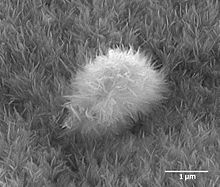Polymer is the big
molecules having high molecular mass which are obtained by the combination of
large number of small molecule called monomer. The term ‘polymer’ derived from
Greek word and has meaning many parts. Polymers
are materials made of long, repeating chains of molecules.
A polymer can be a
three dimensional organization (think about the rehashing units connected
together left and right, front and back, here and there) or two-dimensional
organization (think about the rehashing units connected together left, right,
up, and down in a sheet) or a one-dimensional organization (think about the
rehashing units connected left and right in a chain). Each rehashing unit is
the "- mer" or essential unit with "poly-mer" which means
many rehashing units. Rehashing units are frequently made of carbon and
hydrogen and in some cases oxygen, nitrogen, sulfur, chlorine, fluorine,
phosphorous, and silicon. To make the chain, numerous connections or "-
mers" are artificially snared or polymerized together. Connecting
innumerable portions of development paper together to make paper laurels or
snaring together several paper clasps to shape chains, or hanging dabs
envisions polymers.

Polymers are both
man-made and normally happening. Elastic, for instance, is a characteristic
polymeric material that has been utilized for a great many years. It has superb
flexible characteristics, the consequence of a sub-atomic polymer chain made by
earth. Another characteristic polymer is shellac, a gum created by the lac bug
in India and Thailand, which is utilized as a paint preliminary, sealant, and
stain. From the strand of our DNA which is a normally happening biopolymer to
polypropylene which is utilized all through the world as plastic.
Polymers are not
limited to monomers of a similar substance arrangement or sub-atomic weight and
structure. Some characteristic polymers are made out of one sort of monomer.
Generally characteristic and engineered polymers, be that as it may, are
comprised of at least two unique kinds of monomers; such polymers are known as
copolymers.
Polymers might be
normally found in plants and creatures (characteristic polymers) or might be
man-made (manufactured polymers). Various polymers have various one of a kind
physical and substance properties because of which they discover use in regular
daily existence. Contingent upon the ideal use, polymers can be calibrated to
use certain worthwhile properties. These include:
- Reflectivity: Some polymers are used to produce
reflective film, which is used in a variety of light-related technologies.
- Impact Resistance: Sturdy plastics that can
withstand rough handling are perfect for luggage, protective cases, car
bumpers, and more.
- Brittleness: Some forms of polystyrene are hard
and brittle and easy to deform using heat.
- Translucence: See-through polymers, including
polymer clay, are often used in arts and crafts.
- Ductility: Unlike brittle polymers, ductile
polymers can be deformed without falling apart. Metals such as gold,
aluminum, and steel are known for their ductility. Ductile polymers, while
not as strong as other polymers, are useful for many purposes.
- Elasticity: Natural and synthetic rubbers have
elastic properties that make them ideal for car tires and similar products.
Organic
polymers play a crucial role in living things, providing basic structural
materials and participating in vital life processes. For example, the solid
parts of all plants are made up of polymers. These include cellulose, lignin,
and various resins. Cellulose is a polysaccharide, a polymer that is composed
of sugar molecules. Lignin consists of a complicated three-dimensional network
of polymers. Wood resins are polymers of a simple hydrocarbon, isoprene.
Another familiar isoprene polymer is rubber.
Other
important natural polymers include the proteins, which are polymers of amino
acids, and the nucleic acids, which are polymers of nucleotides—complex
molecules composed of nitrogen-containing bases, sugars, and phosphoric acid.
The nucleic acids carry genetic information in the cell. Starches, important
sources of food energy derived from plants, are natural polymers composed of
glucose.
Many
inorganic polymers also are found in nature, including diamond and graphite.
Both are composed of carbon. In diamond, carbon atoms are linked in a
three-dimensional network that gives the material its hardness. In graphite,
used as a lubricant and in pencil “leads,” the carbon atoms link in planes that
can slide across one another.
Synthetic
polymers are produced in different types of reactions. Many simple
hydrocarbons, such as ethylene and propylene, can be transformed into polymers
by adding one monomer after another to the growing chain. Polyethylene,
composed of repeating ethylene monomers, is an addition polymer. It may have as
many as 10,000 monomers joined in long coiled chains. Polyethylene is
crystalline, translucent, and thermoplastic—i.e., it softens when heated. It is
used for coatings, packaging, molded parts, and the manufacture of bottles and
containers. Polypropylene is also crystalline and thermoplastic but is harder
than polyethylene. Its molecules may consist of from 50,000 to 200,000
monomers. This compound is used in the textile industry and to make molded
objects.
Other
addition polymers include polybutadiene, polyisoprene, and polychloroprene,
which are all important in the manufacture of synthetic rubbers. Some polymers,
such as polystyrene, are glassy and transparent at room temperature, as well as
being thermoplastic. Polystyrene can be coloured any shade and is used in the
manufacture of toys and other plastic objects.
If
one hydrogen atom in ethylene is replaced by a chlorine atom, vinyl chloride is
produced. This polymerizes to polyvinyl chloride (PVC), a colourless, hard,
tough, thermoplastic material that can be manufactured in a number of forms,
including foams, films, and fibres. Vinyl acetate, produced by the reaction of
ethylene and acetic acid, polymerizes to amorphous, soft resins used as
coatings and adhesives. It copolymerizes with vinyl chloride to produce a large
family of thermoplastic materials.










